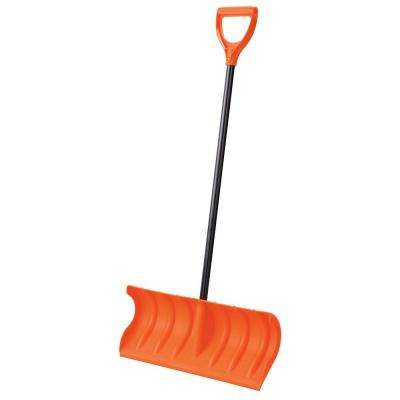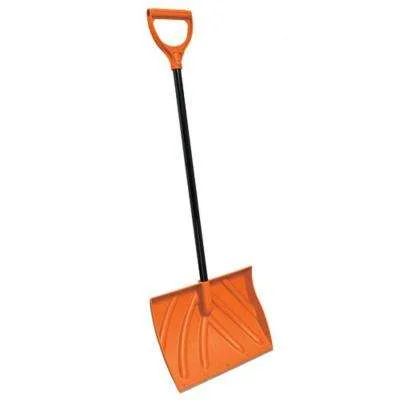
Snow Shoveling Pain: A Guide to Injury Prevention & Recovery
Shoveling can be a great form of exercise but comes with a high risk of injury. Our chiropractors break down the movement of shoveling and how to reduce your risk of injury.
Did you know that about 56% of snow related trips to an emergency room are sprains and strains? Since we are experts in sprain/strain injuries, we thought we would give you a couple exercises to help with the soreness and pain from shoveling.
Before we get into the stretches, let’s first examine the complex movement of shoveling. Shoveling is a combination of squatting, lunging, bending, lifting, pulling and twisting all packed together. When performed with proper body awareness, shoveling can be a great workout. However, shoveling is typically performed more as a chore over a long duration with little breaks. As you get tired, your movement patterns begin to break down and you become more susceptible to injury. Movements like bending at the spine, twisting too quickly and holding the shovel too far away from the body can often lead to muscle strains.
Hip Flexor Stretch
Our first exercise is a hip flexor stretch. To perform start in a half kneeling position as pictured below. Squeeze your glutes and shift forward slightly without extending at your low back. You should feel a stretch in the front of the hip and thigh. You can increase this stretch by reaching the arm of the knee that is on the ground overhead. Hold for 10-20 seconds and perform 3 repetitions on each side.
Standing Extension Stretch
Our second exercise is a standing extension stretch. First, stand near a wall with the elbows bent to 90 degrees. Move toward the wall until the finger tips touch the wall. Place hands shoulder height like you would perform a pushup. Slowly extend your spine and head in a gentle wave like motion. Take this movement slowly and try to increase range of motion as you go. Perform 2 sets of 10 repetitions
Upper Extremity Stretch
Our last exercise is a biceps and forearm stretch at the wall. To start, place your palm on the wall with the thumb up with a slight bend at the elbow. Slowly attempt to straighten the elbow and turn your body away from the wall. This can sometimes be an intense stretch so perform as tolerated. Try holding for 10-30 seconds 3 times on each arm.
We hope you find these exercises helpful during the upcoming winter! Please remember these exercises should not be used to treat or evaluate any injuries. They should also not cause you any increase in symptoms. If you have any questions, please contact our office. And for more information, check out our video.
Tips for Running in the Winter
Running in Saratoga Springs can be great in the summer but challenging in the winter. This article has some tips on staying safe if you chose to venture outside to get your miles in. Our Saratoga Springs chiropractic office has helped many runners stay fit and healthy through the winter months while still training outside.
Tips for Running in the Winter
Running is one of the most popular sports in the country. It requires little gear, no membership, and you can run anywhere. As long as you have a pair of shoes and some time, you can run. That is, unless you live in the Northeast. Running in the summer around Saratoga Springs is amazing. One can get lost running by old victorians, through the Saratoga Spa State Park or through the Saratoga Battlefield. The winter months can make you think twice about your choice of exercise. If you’re determined to continue training, here are a few tips.
Be Seen
If you are like most people, your running times are either early in the morning or after work which means you’ll likely be running in the dark. We suggest you wear reflective gear on the middle of your body, and somewhere on your arms or legs. If you want to go the extra mile (no pun intended), wear a headlamp as well. Snowbanks may also prevent drivers from seeing you so be alert when you are crossing streets or going into traffic.
Proper Shoes
Most running shoes are designed with mesh to keep your feet cool. In the winter, you want shoes that have the least amount of mesh. This will not only keep your feet warm, but keep out the snow and water. Of course, you also want a good pair of socks to go with those shoes and we recommend non-itchy wool socks.
Dress Appropriately
Dressing in layers is key. The air trapped between the layers is warmed by your body and acts as insulation. The biggest thing is to dress as if it were about 20 degrees warmer. You don’t want to sweat too much when you are running in the cold. That could lead to chills when you are done.
Warm up
Warming up before you head outside will make those first few minutes less stressful on your body. In other words, the cold won’t feel as cold. Especially since you were just told to dress as if it were warmer. Doing body-weight squats or lunges are a good way to get the blood flowing through your legs.
Slow down
Running outside means facing obstacles you may not know are there. Slipping is a serious danger for anyone who ventures outside in the winter months. Make sure you slow down your pace, take shorter strides, and strike the ground with a flat foot. This will help minimize the risk of slipping.
Post run recovery
After you are finished your run it is important to get out of your sweaty or wet clothes and put some dry warm clothes on. After exercise, your core temperature drops and puts you at risk for getting chills. Once you are in dry clothes, it is a good idea to drink warm fluids or have some soup. This will help you hydrate and warm your body.
Treadmill Running
If you are not interested in running in the cold or if conditions are too dangerous, the treadmill is a good alternative. To get the most out of the treadmill, put it at a 1% incline. If the treadmill has built-in fans, turn them on high as well. The incline activates the muscles required to propel you forward while the fans activate the sensory cells on your skin and remind your brain of running outside.
Whether you run in the cold, snowy weather or inside on the treadmill, it is important to stay hydrated, stretch, and take care of injuries as soon as they start. At our Saratoga Springs chiropractic office, we offer free injury screens and would be happy to answer your questions about running.
For the best running gear and expert fittings, check out our friends at iRun Local or Fleet Feet Sports!
Picking the Perfect Snow Shovel
There are so many choices when picking a shovel in Saratoga Springs. How can you tell what works and what is a great marketing ploy? Check out this article where we discuss different shovels.
Straight handle, curved handle, flat blade, scooped blade. There are so many options when selecting a snow shovel it can be overwhelming. We have done some research, and testing of our own, to give you the scoop on the best snow removal tools.
Straight vs. Curved Handle
Curved handle snow shovels have been out for a few years. But are they worth the money? The short answer is ‘maybe’. The idea behind a short handle is to reduce bending forward when you scoop the snow. In some studies, a bent handle can reduce the load on the lower back by up to 16%. That reduction in load could add up depending on how much snow you are moving and how heavy. One thing to note is that only considers lifting the snow, not throwing it. The trick to shoveling is to use your legs to get most of your power. As people fatigue, they use their lower back instead of their legs to create force and leverage. A concept that can lead to a great deal of pain in following days.
Now that you’ve lifted the snow off the ground, what do you do with it? The ergonomics of a curved handle cause the majority of the weight to be on the front hand due to an inefficient lever. When you try and clear the snow, that font hand, wrist, elbow and shoulder must work harder than with a straight handle.
Based on our research and own experience, we feel it is best to use a traditional straight handle and reduce the risk of injury to multiple body parts. Plus, you most likely grew up shoveling with a straight handle so you are already accustomed to that design.
In this category, the straight shovel is our favorite!
Snow Shovel vs. Snow Push Shovel
I have to be honest, until I really started to look into this I had no idea how many snow shovels there really were. For the sake of keeping things relatively simple, I have narrowed it down to the two most popular varieties.
To determine which one is best you need to understand what each is intended to be used for. Let’s start with the snow shovel. This has more of a flat and square blade and is best for lifting the snow. Let’s say you are clearing a sidewalk and need to pile the snow; a snow shovel may be your best bet. The push shovel is best for, well, pushing snow. In the instance of light, powdery snow a push shovel may be best to clear large areas where you don’t have to lift the snow. These blades are usually wider (18-24”) and have a rounded feature. For most people the most versatile shovel will be the traditional snow shovel as this will allow you to both push and lift the snow.
We only covered two of the many types of snow shovels but we encourage you to check out other kinds and if you have questions, let us know.
No matter what shovel you choose, please make sure you dress warm, stretch before you shovel and stay hydrated. The majority of injuries we see after a snow storm are related to shoveling snow. For more information on how to keep yourself healthy when the snow piles up, check out our post “A Chiropractor’s Guide to Surviving a Snow Storm”.
Happy Shoveling!
A Chiropractor's Guide to Surviving a Snowstorm
Saratoga Springs is known as being a Summer destination, but the Winters an be just as fun. Whether you hate the snow or love, this article is all about staying healthy when the snow falls.
Living in Saratoga Springs just about guarantees at least one snowstorm each winter. When this happens, you may find yourself shoveling snow, running inside or packing your gear to head to the mountain. Whether you’re dreading the snow or dreaming of it, check out this chiropractic guide to staying healthy for any snowstorm.
Shoveling
Shoveling snow is hard to avoid during a big storm. Whether you’re just cleaning off your sidewalk or clearing your driveway, there are a few things to keep in mind.
The green outlines posterior and anterior oblique slings. The muscle system that is dominant when doing rotational activity. These can be easily overworked on one side when shoveling.
Timing
Most people end up shoveling in the morning. If that is the case, don’t roll out of bed, throw on your clothes and head outside. Shoveling is strenuous work and a proper warm up is required. Even if that means waiting for 10 minutes and just doing some basic stretches to get your body loose.
We also recommend that you don’t eat right before you shovel. You will be moving close to 100 pounds of snow every minute. That requires a great deal of effort from your body. As with any exercise, your heart rate raises to deliver oxygen to your tiring muscles. Eating a big meal also requires an increase in heart rate and pulls blood away from the heart to aid in digestion. There are many cases of people suffering heart attacks from eating right before shoveling. Just because you’re using your snow blower doesn’t mean you’re out of the clear either. Physical stress is physical stress, your heart doesn’t know the difference.
Mechanics
The way you shovel can increase your risk of injury, especially if the snow is heavy. Make sure to bend your knees, keep the shovel close to you and move your feet. It is also beneficial to switch sides that you hold the shovel on. I know this may feel strange but it will help you build balance and strength and take let one group of muscles rest while another is working.
If you are looking for that perfect shovel and are confused about the different options, check out our post “Picking the Perfect Snow Shovel”.
Winter Sports
Dress warm
Whether you’ll be building a snowman or hitting the slopes, it is important to have the proper clothing to keep you warm. Make sure you dress in layers. Dressing in layers traps a thin amount of air that can be heated by your body to further keep you warm. Multiple layers also helps keep you dry by adding additional protection against melting snow.
keep your neck covered
When the temperature drops, the natural reaction is to tilt your head down and put your mouth and nose in your jacket. This will warm the air entering your mouth and keep your core warm. The problem is this can lead to a great deal of neck pain, shoulder pain, and headaches. So instead, make sure you wear something to keep your neck and face warm, and practice good posture.
Stay hydrated
The last, but certainly not least piece of advice, is to stay hydrated. Our bodies use water to regulate temperature. In the summer months, it is easier to tell when we are getting dehydrated but when you are cold, symptoms can be less obvious. Most people choose to get a warm beverage like coffee during colder months. It is important to note that coffee is a diuretic and that water needs to be replaced. If you drink coffee, make sure to consume double the amount of water as coffee that you drank.
Saratoga Springs transforms into a magical place after a snowstorm. At Turning Point Chiropractic, we hear the good and not-so-good impacts of snow. If you find yourself in pain, don’t make the mistake of waiting to get treated. Taking care of yourself is the only way to ensure you will enjoy all that winter has to offer. If you have any questions, give us a call. We are here to help!



















